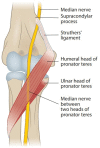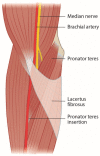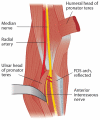Proximal Median Nerve Compression in the Differential Diagnosis of Carpal Tunnel Syndrome
- PMID: 35887752
- PMCID: PMC9317082
- DOI: 10.3390/jcm11143988
Proximal Median Nerve Compression in the Differential Diagnosis of Carpal Tunnel Syndrome
Abstract
Carpal tunnel syndrome (CTS) is the most common median nerve compression neuropathy. Its symptoms and clinical presentation are well known. However, symptoms at median nerve distribution can also be caused by a proximal problem. Pronator syndrome (PS) and anterior interosseous nerve syndrome (AINS) with their typical characteristics have been thought to explain proximal median nerve problems. Still, the literature on proximal median nerve compressions (PMNCs) is conflicting, making this classic split too simple. This review clarifies that PMNCs should be understood as a spectrum of mild to severe nerve lesions along a branching median nerve, thus causing variable symptoms. Clear objective findings are not always present, and therefore, diagnosis should be based on a more thorough understanding of anatomy and clinical testing. Treatment should be planned according to each patient's individual situation. To emphasize the complexity of causes and symptoms, PMNC should be named proximal median nerve syndrome.
Keywords: carpal tunnel syndrome; median nerve entrapment; median neuropathy; neuralgic amyotrophy; pronator syndrome.
Conflict of interest statement
The authors declare no conflict of interest.
Figures









Similar articles
-
Differential Diagnosis and Intervention of Proximal Median Nerve Entrapment: A Resident's Case Problem.J Orthop Sports Phys Ther. 2016 Sep;46(9):800-8. doi: 10.2519/jospt.2016.6723. Epub 2016 Aug 5. J Orthop Sports Phys Ther. 2016. PMID: 27494058
-
Ulnar Tunnel Syndrome, Radial Tunnel Syndrome, Anterior Interosseous Nerve Syndrome, and Pronator Syndrome.Instr Course Lect. 2017 Feb 15;66:153-162. Instr Course Lect. 2017. PMID: 28594495
-
Proximal Median Nerve Compression: Pronator Syndrome.J Hand Surg Am. 2020 Dec;45(12):1157-1165. doi: 10.1016/j.jhsa.2020.07.006. Epub 2020 Sep 4. J Hand Surg Am. 2020. PMID: 32893044 Review.
-
Ulnar Tunnel Syndrome, Radial Tunnel Syndrome, Anterior Interosseous Nerve Syndrome, and Pronator Syndrome.J Am Acad Orthop Surg. 2017 Jan;25(1):e1-e10. doi: 10.5435/JAAOS-D-16-00010. J Am Acad Orthop Surg. 2017. PMID: 27902538
-
Pronator syndrome and other nerve compressions that mimic carpal tunnel syndrome.J Orthop Sports Phys Ther. 2004 Oct;34(10):601-9. doi: 10.2519/jospt.2004.34.10.601. J Orthop Sports Phys Ther. 2004. PMID: 15552706 Review.
Cited by
-
Lacertus Fibrosus Syndrome: A Case Report.Cureus. 2023 Oct 16;15(10):e47158. doi: 10.7759/cureus.47158. eCollection 2023 Oct. Cureus. 2023. PMID: 38021701 Free PMC article.
-
Recent Research Provides Significant New Information about Predisposing Factors, Diagnostic Practices, and Treatment of Carpal Tunnel Syndrome.J Clin Med. 2022 Sep 14;11(18):5382. doi: 10.3390/jcm11185382. J Clin Med. 2022. PMID: 36143029 Free PMC article.
-
Safety and Efficacy of Ultrasound-Guided Perineural Hydrodissection as a Minimally Invasive Treatment in Carpal Tunnel Syndrome: A Systematic Review.J Pers Med. 2024 Jan 30;14(2):154. doi: 10.3390/jpm14020154. J Pers Med. 2024. PMID: 38392587 Free PMC article. Review.
-
Imaging of elbow entrapment neuropathies.Insights Imaging. 2025 Jan 29;16(1):24. doi: 10.1186/s13244-025-01901-1. Insights Imaging. 2025. PMID: 39881040 Free PMC article.
-
Predicting median nerve depth from anthropometric features: A tool for safer invasive procedures.PLoS One. 2025 Aug 18;20(8):e0330383. doi: 10.1371/journal.pone.0330383. eCollection 2025. PLoS One. 2025. PMID: 40824904 Free PMC article.
References
Publication types
Grants and funding
LinkOut - more resources
Full Text Sources
Research Materials

